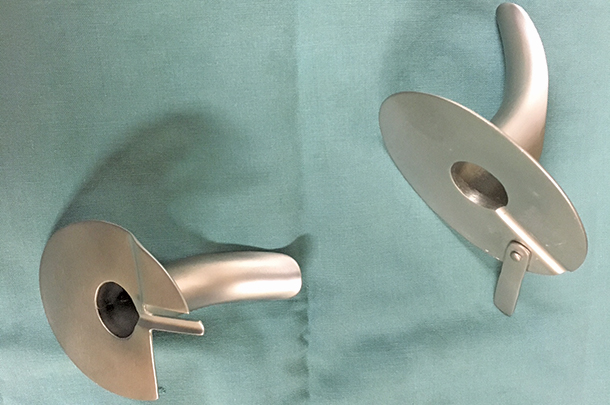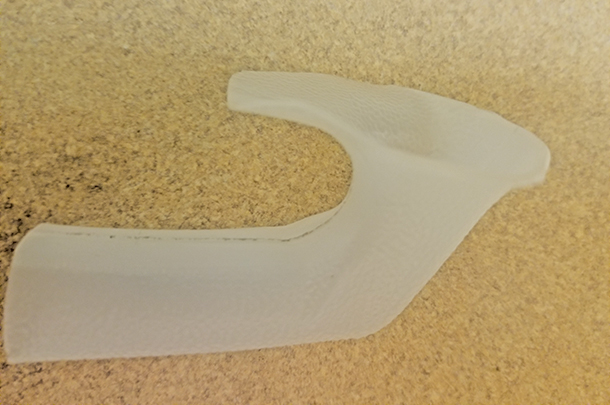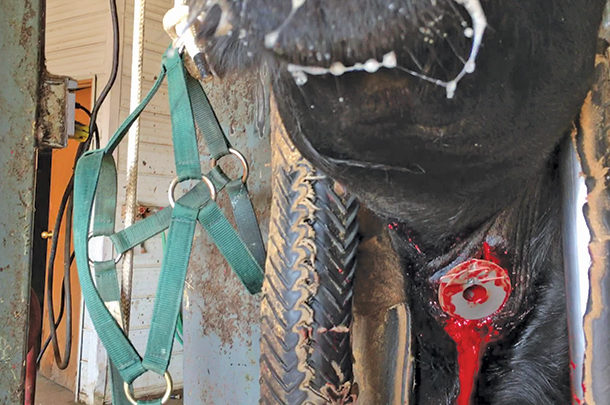Respiratory problems in cattle include diphtheria, the infection or inflammation of vocal folds of the larynx (voice box) at the back of the throat. Infection (necrotic laryngitis) and swelling from inflammation restricts airways and breathing is difficult. Air must travel through the larynx into windpipe and lungs. Swelling may cause death from suffocation. Severe cases may lead to extensive infection that gets into the lungs, causing pneumonia or septicemia that may quickly kill the calf.
When we see signs of respiratory distress, the first assumption is usually pneumonia, according to Dr. Robert Cope, a veterinarian in Salmon, Idaho, but calves and occasionally adult cattle can develop infection in mouth and throat caused by a gram-negative bacteria (Fusobacterium necrophorum). “This bacteria also causes foot rot in cattle and navel infections in calves,” says Cope.
This opportunistic organism is present in the environment, causing disease when conditions are right, such as injury to membranes of mouth and throat. “If the calf chews on something sharp, a scratch on the larynx may open the way for infection,” he says.
Diphtheria is not contagious animal-to-animal but generally follows a sore mouth or throat, or abrasions from coarse, rough feed or sharp seeds. If infection is confined to the mouth, the calf may have mild fever and be off-feed. He may slobber, with swelling in the cheek area. Examination of the mouth may reveal ulcers in cheek membranes, and sometimes the tongue, and swelling. Breath may be foul. If larynx and pharynx become infected, the calf may cough and drool saliva because he has a hard time swallowing.
“At first glance, you may think it’s pneumonia, because breathing is difficult,” says Cope. “With pneumonia, the calf is depressed with head down and ears drooped. There is often nasal discharge. In diphtheria, the head is usually extended, parallel to the ground or higher, with no evidence of snotty nose.”
The calf may still be bright and alert because this is not a systemic infection like pneumonia (at least not at first), but he may not be nursing. He may stand by mom fiddling with her teats but not nursing because it is difficult to swallow or to breathe while trying to suckle.
The typical sign of diphtheria (as opposed to pneumonia) is difficulty drawing air into the lungs due to obstruction in the throat. A calf with pneumonia has trouble pushing air out due to damaged lungs. “Calves with pneumonia often grunt while exhaling. By contrast, diphtheria infection occurs in the larynx. The effect is like soaking a doughnut. The outside becomes bigger, but the hole in the center becomes smaller. As the larynx swells and the opening through it shrinks, breathing is impaired,” says Cope. You may hear the calf wheezing due to constricted air passages.
Eventually, he may develop high fever. Death usually occurs from toxemia (bacteria toxins circulating in the bloodstream) or obstruction of airways by the second to seventh day of illness. Spread of infection to the lungs may cause severe bronchopneumonia.
Tools for treatment
 A commercial diphtheria insert tool is inserted into a slit in the windpipe after opening it with a tracheostomy. Photo by Dr. Lee Meyring.
A commercial diphtheria insert tool is inserted into a slit in the windpipe after opening it with a tracheostomy. Photo by Dr. Lee Meyring.
Cope says treatment must be quick and aggressive with systemic antibiotics, or scarring can make restriction permanent even after the infection is eliminated. “I use LA-200, Naxcel and other antibiotics. None seem greatly superior for treating diphtheria. I do not recommend boluses because shoving pills down the throat may worsen the condition.” Treatment should be continued until the animal is fully recovered, and this may take several weeks in some cases.
“No matter what antibiotic is used, I also give a corticosteroid to reduce laryngeal swelling and try to prevent formation of scar tissue,” says Cope. “My preference is dexamethasone, given at least twice daily for the first three to five days. Steroids suppress the immune system if given for more than a few days, but it’s safe to give dexamethasone at the beginning, especially if the calf is on antibiotics.”
Dr. Ted Clark, retired veterinarian and pathologist in Calgary, Alberta, says that if you can hear the calf breathing, you need to treat quickly. “If you don’t halt infection and there is tissue damage, the calf may get a mixed bacterial infection in necrotic tissue in the larynx and nasopharynx. This can spread rapidly, and the calf may die,” he says.
“You can open the mouth and look at the throat – grabbing the tongue and pulling it aside with someone holding a light. This might enable you to see the location and how extensive the necrosis is, which may help determine the best treatment.” Sometimes the infection is in the mouth, rather than throat, and not as likely to close off the airways.
“Keep in mind, however, that the calf might inhale necrotic material mixed with bacteria into the lungs. The result is secondary inhalation pneumonia, which can also kill the calf. These cases can be difficult to treat. If it’s a mixed bacterial infection, with both aerobic and anaerobic bacteria such as Fusobacterium necrophorum, it can be challenging to save the calf,” Clark says.
Keeping airways open
Dr. Lee Meyring, a veterinarian in Steamboat Springs, Colorado, says that if swelling shuts off air passages, the animal will die unless you or your veterinarian perform emergency tracheostomy. This involves slitting the windpipe at the front, horizontally, with a sharp, clean knife, a few inches below the jaw.
“Be careful to cut just through softer tissue, between the firm ribs of the windpipe, like cutting between the ribs of a vacuum cleaner hose. Air can go in and out through this opening, bypassing obstruction in the throat. This can keep the calf alive and breathing until the vet gets there,” he says.
The slit can be kept open with a tube or fingers until the vet can insert a tracheal tube. This allows the animal to breathe until swelling in the throat resolves. Then the opening can be sewed shut so it can heal.
A stainless-steel tracheostomy insert can keep the incision open and bypass the swollen, irritated larynx; the calf breathes through the hole in his windpipe. This insert comes in two pieces.
 A makeshift version can be crafted from a milk jug handle. Photo by Dr. Lee Meyring.
A makeshift version can be crafted from a milk jug handle. Photo by Dr. Lee Meyring.
“I’ve also used the handle of a plastic milk jug as a tube that fits into the trachea and down into the windpipe. We suture the plastic to the skin, to secure it, and hope the swelling in the vocal cords subsides so the calf can breathe normally again. Commercial inserts have a rounded tube and a flat edge for suturing to the skin. We use gauze as an air filter so no foreign material goes into that breathing hole,” Meyring explains.
Bypassing the larynx removes the constant irritation (air forced past the swollen folds of the larynx with every breath). You still need to keep treating with antibiotics until the infection is gone.
“I use dexamethasone daily for only three days but keep going with antibiotic for as long as it takes to get the calf recovered,” he says.
If the calf is still having trouble breathing, you can use dimethyl sulfoxide (DMSO) to reduce swelling in the throat. DMSO can be given intravenously (1 cc per 100 pounds of bodyweight) or orally at higher doses.
Either way, it is absorbed throughout the body. For a calf with diphtheria, DMSO can be given as a gargle drench, mixed with a little water and squirted into the back of the mouth a couple times daily, to shrink throat swelling.
Use of DMSO in food animals is controversial, and some veterinarians won’t prescribe it. Others, like Meyring, recognize its value in a young calf that won’t enter the food chain for a long time, since DMSO might save its life.








